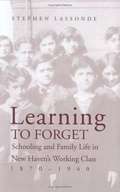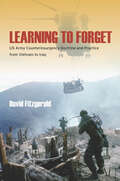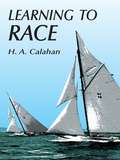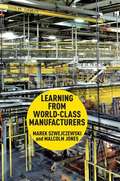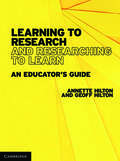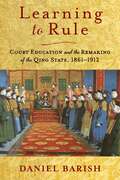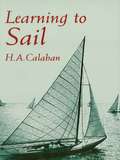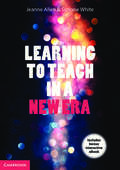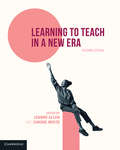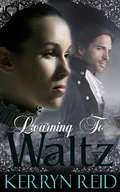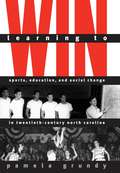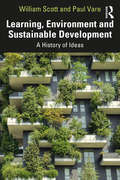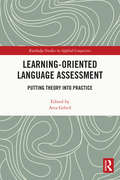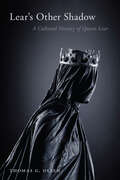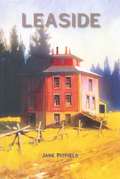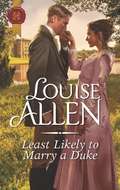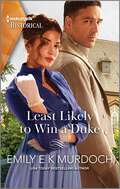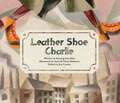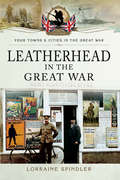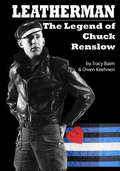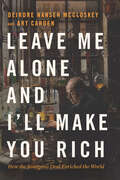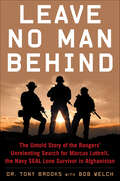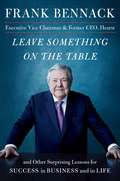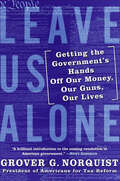- Table View
- List View
Learning to Forget: Schooling and Family Life in New Haven's Working Class, 1870-1940
by Stephen LassondeThis book offers an insightful view of the complex relations between home and school in the working-class immigrant Italian community of New Haven, Connecticut. Through the lenses of history, sociology, and education, Learning to Forget presents a highly readable account of cross-generational experiences during the period from 1870 to 1940, chronicling one generation's suspicions toward public education and another's need to assimilate. Through careful research Lassonde finds that not all working class parents were enthusiastic supporters of education. Not only did the time and energy spent in school restrict children's potential financial contributions to the family, but attitudes that children encountered in school often ran counter to the family's traditional values. Legally mandated education and child labor laws eventually resolved these conflicts, but not without considerable reluctance and resistance.
Learning to Forget: US Army Counterinsurgency Doctrine and Practice from Vietnam to Iraq
by David FitzgeraldLearning to Forgetanalyzes the evolution of US counterinsurgency (COIN) doctrine over the last five decades. Beginning with an extensive section on the lessons of Vietnam, it traces the decline of COIN in the 1970s, then the rebirth of low intensity conflict through the Reagan years and the conflict in Bosnia, culminating in the campaigns in Iraq and Afghanistan. It explains how the lessons of Vietnam led the Army to Iraq and the way in which their confronting and reimagining of these lessons offered them a way out of that war. In the process it provides an illustration of how military leaders make use of history and demonstrates the difficulties of drawing lessons from the past that can usefully be applied to contemporary circumstances. The book outlines how the construction of lessons is tied to the construction of historical memory and describes the interplay between the two processes—demonstrating how histories are constructed to serve the needs of the present. In so doing, it creates a new theory of doctrinal development.
Learning to Race
by H. A. CalahanClassic guide for sailors who want to win yacht races. Expert, detailed discussions of how to get the most speed out of the boat: crew and equipment, the start, taking advantage of tides and currents, tactics, strategy, and much more. Also, thorough discussion of fundamentals. Over 50 black-and-white illustrations.
Learning to Read in the Late Ottoman Empire and the Early Turkish Republic
by Benjamin C. FortnaAn exploration of the ways in which children learned and were taught to read, against the background of the transition from Ottoman Empire to Turkish Republic. This study gives us a fresh perspective on the transition from empire to republic by showing us the ways that reading was central to the construction of modernity.
Learning to Research and Researching to Learn: An Educator's Guide
by Annette Hilton Geoff HiltonBeing an educator involves continual reflection on practice to improve student learning and engagement. Learning to Research and Researching to Learn is an essential introduction to developing research skills and conducting practitioner research in the field of education. Learning to Research and Researching to Learn covers all aspects of educational research, from how to conduct and engage with research, to how to collect, organise and analyse data. Using real-world examples and practitioner findings, the text encourages student and practitioner engagement through discussion questions and case studies relevant to educators in early childhood, primary and secondary contexts. Written by authors with extensive experience as both teachers and researchers, Learning to Research and Researching to Learn is an invaluable resource for educators in all stages of their professional careers.
Learning to Rule: Court Education and the Remaking of the Qing State, 1861–1912 (Studies of the Weatherhead East Asian Institute, Columbia University)
by Daniel BarishIn the second half of the nineteenth century, local leaders around the Qing empire attempted to rebuild in the aftermath of domestic rebellion and imperialist aggression. At the same time, the enthronement of a series of children brought the question of reconstruction into the heart of the capital. Chinese scholars, Manchu and Mongolian officials, and writers in the press all competed to have their ideas included in the education of young rulers. Each group hoped to use the power of the emperor—both his functional role within the bureaucracy and his symbolic role as an exemplar for the people—to promote reform.Daniel Barish explores debates surrounding the education of the final three Qing emperors, showing how imperial curricula became proxy battles for divergent visions of how to restabilize the country. He sheds light on the efforts of rival figures, who drew on China’s dynastic history, Manchu traditions, and the statecraft tools of imperial powers as they sought to remake the state. Barish traces how court education reflected arguments over the introduction of Western learning, the fate of the Manchu Way, the place of women in society, notions of constitutionalism, and emergent conceptions of national identity. He emphasizes how changing ideas of education intersected with a push for a renewed imperial center and national unity, helping create a model of rulership for postimperial regimes. Through the lens of the education of young emperors, Learning to Rule develops a new understanding of the late Qing era and the relationship between the monarchy and the nation in modern China.
Learning to Sail
by H. A. CalahanThis classic guide for the first-time sailor centers on the small sailboat. The author, who assumes no prior knowledge on the part of the reader, begins with the selection of a first boat and conveys enough information to enable anyone to take out a small boat and bring her in safely. 111 black-and-white figures.
Learning to Teach in a New Era
by Allen, Jeanne and White, SimoneLearning to Teach in a New Era prepares preservice teachers to embrace the opportunities and meet the challenges of teaching in the twenty-first century. Closely aligned with the Australian Professional Standards for Teachers (APST) and the Australian Curriculum, this book is an invaluable resource for early childhood, primary and secondary preservice teachers that can be carried through their entire degree and into the workplace. The text is divided into three parts: professional knowledge, professional practice and professional engagement. Students will gain an understanding of the teaching profession and the policies and laws that govern it; develop practical skills in pedagogy, technology, curriculum, assessment and reporting, planning and classroom management; and learn vital skills in communication and ethical practice. Each printed text comes with a unique access code to the interactive ebook. Fully integrated with the print book, this enhanced version houses useful assessment tools such as questions and video resources.
Learning to Teach in a New Era
by Simone White Jeanne AllenEntering the teaching profession in the twenty-first century comes with many challenges and even more opportunities to meet the learning needs of Australian students. Learning to Teach in a New Era provides a fundamental introduction to educational practice for early childhood, primary and secondary preservice teachers. Closely aligned with the Australian Curriculum and the Australian Professional Standards for Teachers, this text builds on foundational knowledge and provides guidance on professional development throughout your career in education. Organised in three sections – professional knowledge, professional practice and professional engagement – and thoroughly updated, this text introduces educational policy and the legal dimensions of education; encourages the development of practical skills in pedagogy, planning, assessment, digital technologies and classroom management; and supports effective communication and ethical practice. This edition features a new chapter exploring Aboriginal and Torres Strait Islander ways of knowing, being and doing, enabling teachers to create respectful and culturally responsive classrooms.
Learning to Waltz
by Kerryn ReidDeborah Moore has learned her lessons well--feel nothing, reveal less, and trust no one. Now widowed with a child of her own, she leads a lonely, cloistered existence, counting her farthings and thinking she is safe. When five-year-old Julian is lost one bitter December day, she discovers how tenuous that safety is. Evan Haverfield has lived thirty carefree years, hunting, laughing, and dancing among London's high society. His biggest problem has been finding excuses not to marry. But his life changes when he finds Julian Moore half-frozen under a hedge and carries him home to his mother. The young widow hides behind a mask, hard and reserved, but Evan sees glimpses of another woman, wistful, intelligent, and passionate. She's vulnerable, desirable--and completely unsuitable for the heir to Northridge. Alone in the earliest hours of a new year, Evan teaches Deborah to waltz. Can he teach her joy and laughter? Will love sweep away the shadows of her past and reveal the luminous woman she could be?
Learning to Win
by Pamela GrundyOver the past century, high school and college athletics have grown into one of America's most beloved--and most controversial--institutions, inspiring great loyalty while sparking fierce disputes.In this richly detailed book, Pamela Grundy examines the many meanings that school sports took on in North Carolina, linking athletic programs at state universities, public high schools, women's colleges, and African American educational institutions to social and economic shifts that include the expansion of industry, the advent of woman suffrage, and the rise and fall of Jim Crow. Drawing heavily on oral history interviews, Grundy charts the many pleasures of athletics, from the simple joy of backyard basketball to the exhilaration of a state championship run. She also explores conflicts provoked by sports within the state--clashes over the growth of college athletics, the propriety of women's competition, and the connection between sports and racial integration, for example. Within this chronicle, familiar athletic narratives take on new meanings, moving beyond timeless stories of courage, fortitude, or failure to illuminate questions about race, manhood and womanhood, the purpose of education, the meaning of competition, and the structure of American society.
Learning, Environment and Sustainable Development: A History of Ideas
by William Scott Paul VareThis book is an introduction to the long history of human learning, the environment and sustainable development – about our struggles with the natural world: first for survival, then for dominance, currently for self-preservation, and in future perhaps, even for long-term, mutually beneficial co-existence. It charts the long arc of human–environment relationships through the specific lens of human learning, putting on record many of the people, ideas and events that have contributed, often unwittingly, to the global movement for sustainable development. Human learning has always had a focus on the environment. It’s something we’ve been engaged in ever since we began interacting with our surroundings and thinking about the impacts, outcomes and consequences of our actions and interactions. This unique story told by the authors is episodic rather than a connected, linear account; it probes, questions and re-examines familiar issues from novel perspectives, and looks ahead. The book is of particular interest to those studying (and teaching) courses with a focus on socio-economic and environmental sustainability, and non-governmental organisations whose work brings them face-to-face with the general public and social enterprises.
Learning-Oriented Language Assessment: Putting Theory into Practice (Routledge Studies in Applied Linguistics)
by Atta GebrilThis collection brings together research on learning-oriented language assessment from scholars working across geographic and educational contexts, highlighting the opportunities of assessment practices which seek to better align assessment and learning tasks and support effective learning. The volume begins by introducing learning-oriented assessment (LOA) and the context around its growing popularity, especially in accountability-oriented settings which favor summative large-scale tests. The first part of the book charts the development of LOA’s theoretical and conceptual underpinnings, outlining the ways in which they have been informed by theories of learning and key elements. The second part demonstrates LOA in practice, drawing on examples from different countries and instructional settings to explore such topics as the role of technology in LOA and developing feedback materials based around LOA principles and developed for core literacy skills.Offering a holistic view of learning-oriented assessment and the real-world affordances and challenges of its implementation, this book is key reading for graduate students, researchers, and practitioners in language testing and assessment, TESOL, and language education.
Lear’s Other Shadow: A Cultural History of Queen Lear
by Thomas G. OlsenLear’s Other Shadow: A Cultural History of Queen Lear offers a deep cultural analysis of the figure of Queen Lear, who shadows and eventually sometimes overshadows her royal husband across the nearly one-thousand-year life of this archetypal tale. What appears to be a deliberate strategy of suppression, even erasure in Shakespeare’s King Lear later inspired dozens of stage, page, and cinematic remakes and adaptations in which this figure is revived or remembered, often pointedly so. From Jacob Gordin’s Yiddish-language Miriele Efros (1898), through edgy stage remakes such as Gordon Bottomley’s King Lear’s Wife (1915) and the Women’s Theatre Group’s Lear’s Daughters (1987), to novelized retellings from Jane Smiley’s A Thousand Acres (1991) to Preti Taneja’s We That Are Young (2018) and J. R. Thorp’s Learwife (2021), and even the television series Empire (2015–2020) and Succession (2018–2023), Queen Lear regularly emerges from her shadowy origins to challenge how we understand the ancient King Leir/King Lear story. These and many other examples reveal fascinating patterns of adaptation and reinterpretation that Lear's Other Shadow identifies and analyzes for the first time, showing how and why Queen Lear is at the center of this ancient story, whether she is heard from or not.
Leaside
by Jane PitfieldLeaside is a most comprehensive look at the people, significant events and built heritage, all of which contributed to the creation of this distinctive community. Named after John Lea, a successful farmer, whose house, built in 1829, is believed to be the first brick house in York County, Leaside grew from a railway settlement into a prosperous urban town. With its roots embedded in the history of three railways, Leaside has a unique industrial heritage that played a key role in the war effort during both World Wars, including its being the site of munitions plants, a wooden plane factory, and a base for the Royal Flying Corps. Leaside was also home to the Durant Motors of Canada, and later the Nash cars, Canada Wire and Cable, and the popular Thorncliffe Race Track. Did you know that Canada’s first airmail delivery touched down in Leaside and that an Olympic calibre ski jump once operated in the Don Valley? Jane Pitfield’s Leaside represent a nostalgic journey into the heritage of a most remarkable neighbourhood, still proudly retaining its identity as part of Toronto.
Least Likely to Marry a Duke (Mills And Boon Historical Ser.)
by Louise AllenA marriage of inconvenienceFor the buttoned-up duke!Bound by convention, William Calthorpe, Duke of Aylsham, is in search of a suitable bride to help raise his half siblings. Despite his methodical approach to finding such a lady, he stumbles—quite literally—into freethinking and rebellious bishop’s daughter Verity Wingate. And when they find themselves stranded overnight on a tiny island, compromising them completely, he knows exactly what he must do…“A refreshingly different historical romance and one I’m happy to recommend”— All About Romance on A Lady in Need of an Heir“A marvellous comfort read ... Romance how it should be written”— Goodreads on A Lady in Need of an Heir
Least Likely to Win a Duke (The Wallflower Academy #1)
by Emily E MurdochA sparky and witty Harlequin Historical debutA most unlikely matchFor a most unlikely wallflower! Miss Pike&’s finishing school might be designed to find the most unconventional of debutantes a husband, but Gwendoline Knox didn&’t expect to literally bump into a duke on her first day! Let alone one as distractingly charming as Percy Deveraux. Gwen knows nothing can come of their flirtations, not with their different stations—or her scandalous secret! Still, she can&’t help wishing for more, even if that means confronting her past… From Harlequin Historical: Your romantic escape to the past.The Wallflower AcademyBook 1: Least Likely to Win a DukeBook 2: More Than a Match for the Earl
Leather Shoe Charlie
by Gyeong- hwa KimNational Council for the Social Studies-Children&’s Book Council: 2018 Notable Social Studies Trade Books for Young PeopleAn appealing and educational story about the Industrial Revolution Charlie&’s most prized possession is the pair of shoes his grandfather made for him. The shoes bring him comfort as he and his family leave their small village and move to Manchester. But the pollution from the city&’s many factories soon takes its toll on Charlie&’s mother. Unfortunately, the medicine she needs is too expensive, unless Charlie can make an exceptional sacrifice. This fascinating Trade Winds book presents readers with an engrossing story while also teaching them about Britain&’s Industrial Revolution.
Leatherhead in the Great War (Your Towns & Cities in the Great War)
by Lorraine SpindlerAt the beginning of the twentieth century, Leatherhead was alive with celebration. The Boer War had ended in May 1902, King Edward VIIs Coronation followed in August and the had town blossomed into one of prosperous development.Things quickly changed when the war broke out in 1914, leaving the town papered with recruiting posters and swarming with soldiers. The upheaval was especially felt by the local families as they initially waved off over 400 Leatherhead men into the forces. Those left behind attempted to live a normal life in extraordinary circumstances, with Zeppelin raids in nearby Guildford and Croydon, which encouraged Leatherheads newspapers to offer insurance against the destruction of homes, the banning of lights after dark and fines for those who ignored the dictates. Added to the locals distress was the news of the high casualty rate of local soldiers and those previously billeted in the town, wiped out at the Battle of Delville Wood.The spring of 1918 felt especially bleak with shortages of food, labour, fuel and little prospect of an end to the conflict. However, later that year the end of war was finally declared. Of the 983 Leatherhead men who served, 163 were dead.On 19 July 1919, Leatherhead joined with the nation to celebrate peace. A lunch for returning servicemen was laid out and a procession of over 2,000 Leatherhead residents proceeded to Randalls Park. As the Silver Band played the town rejoiced with fireworks, dancing and the customary bonfire. Though warmed by the flames of celebration, Leatherhead was irrevocably altered.
Leatherman: The Legend of Chuck Renslow
by Tracy Baim Owen KeehnenA prominent Chicago gay activist and entrepreneur is the subject of an in-depth biography, Leatherman: The Legend of Chuck Renslow, by journalists and authors Tracy Baim and Owen Keehnen. Living as an openly gay man in 1950s Chicago was no easy task. For Chuck Renslow, that was only his first of many bold moves. Just out of high school he began what was to become a six-decade empire, starting more than two dozen businesses in Chicago, as well as a few in other cities. He has owned bars, discos, photo studios, health clubs, bathhouses, gay magazines and newspapers, hotels, restaurants, and bookstores. Throughout it all he dealt with Mafia and police payoffs, anti-gay political policies, harassment from censors, and even controversy within the gay community. In the mid-1950s, after having a portrait and then cheesecake studio, Renslow began experimenting with beefcake photography and began Kris Studio. With his longtime lover, the artist Dom Orejudos aka Etienne and Stephen, at his side, Renslow created Kris Studio a leader in male physique photography, resulting in such magazines as Triumph, Mars and The Rawhide Male, producing thousands of erotic images as well as several films. In 1959 Renslow took over the Gold Coast Show Lounge and transformed it into one of the most lowdown libidinous gay leather bars in the world. With Etienne's murals adorning the walls, a leather/Western/uniform dress code for patrons, and a dark Pit that featured all sorts of goings-on, the Gold Coast set the standard for raunchy kink and gay sexual liberation. It was the birthplace of motorcycle clubs and sex groups, but above all a place for people to meet, connect, and explore themselves and their sexuality. The Gold Coast was also the birthplace of the first leather contest, which in the span of a few short years evolved beyond the bar's capacity and became International Mr. Leather in 1979. More than three decades later, it continues to be one of the world's most popular gay events. Renslow was also one of the pioneers in taking a bathhouse beyond merely the borders of a mere sex club. Man's Country became something truly unforgettable in the 1970s - a sex-and-entertainment complex with a variety of rooms, shops, and a Music Hall that attracted top names touring in the "K-Y circuit," from Sally Rand to Wayland Flowers to Rusty Warren and Charles Pierce. Renslow was a dynamic force in Chicago politics under mayors starting with Richard J. Daley, and he ran to be a delegate for Sen. Ted Kennedy's 1980 presidential run. He danced with another man at a 1977 inaugural ball for Jimmy Carter. Renslow helped protest against unfair policies, fought censorship and entrapment, and battled Anita Bryant. He even served as a field contact for the pioneering work at the Kinsey Institute, as well as performing sexual acts for Kinsey researchers. He knew entertainment celebrities from Marlene Dietrich to Rudolf Nureyev, from Divine to Grace Jones, and from Sylvester to Quentin Crisp. In their heyday Chuck Renslow's annual White Parties were celebrations beyond compare. When Chicago's gay community faced the loss of its newspaper, Renslow bailed out and ran GayLife. He also co-founded the Leather Archives & Museum (with Tony DeBlase). Through it all Renslow has also been Daddy of the Family, a unique created group of lovers, tricks, and friends who were bound by sex and oftentimes love and by a goal of providing comfort and support to one another.
Leave It to Abigail!: The Revolutionary Life of Abigail Adams
by Barb RosenstockIn this inspiring tribute, award-winning author Barb Rosenstock and New York Times bestselling artist Elizabeth Baddeley tell the true story of one of America's greatest founding mothers: Abigail Adams.Everyone knew Abigail was different.Instead of keeping quiet, she blurted out questions. Instead of settling down with a wealthy minister, she married a poor country lawyer named John Adams. Instead of running from the Revolutionary War, she managed a farm and fed hungry soldiers. Instead of leaving the governing to men, she insisted they "Remember the Ladies." Instead of fearing Europe's kings and queens, she boldly crossed the sea to represent her new country. And when John become President of the United States, Abigail became First Lady, and a powerful advisor.Leave it to Abigail--an extraordinary woman who surprised the world.
Leave Me Alone and I'll Make You Rich: How the Bourgeois Deal Enriched the World
by Deirdre Nansen McCloskey Art CardenThe economist and historian Deirdre Nansen McCloskey has been best known recently for her Bourgeois Era trilogy, a vigorous defense, unrivaled in scope, of commercially tested betterment. Its massive volumes, The Bourgeois Virtues, Bourgeois Dignity, and Bourgeois Equality, solve Adam Smith’s puzzle of the nature and causes of the wealth of nations, and of the moral sentiments of modernity. The world got rich, she argues, not chiefly by material causes but by an idea and a sentiment, a new admiration for the middle class and its egalitarian liberalism. For readers looking for a distillation of McCloskey’s magisterial work, Leave Me Alone and I’ll Make You Rich is what you’ve been waiting for. In this lively volume, McCloskey and the economist and journalist Carden bring together the trilogy’s key ideas and its most provocative arguments. The rise of the west, and now the rest, is the story of the rise of ordinary people to a dignity and liberty inspiring them to have a go. The outcome was an explosion of innovation after 1800, and a rise of real income by an astounding 3,000 percent. The Great Enrichment, well beyond the conventional Industrial Revolution, did not, McCloskey and Carden show, come from the usual suspects, capital accumulation or class struggle. It came from the idea of economic liberty in Holland and the Anglosphere, then Sweden and Japan, then Italy and Israel and China and India, an idea that bids fair in the next few generations to raise up the wretched of the earth. The original shift to liberalism arose from 1517 to 1789 from theological and political revolutions in northwest Europe, upending ancient hierarchies. McCloskey and Carden contend further that liberalism and “innovism” made us better humans as well as richer ones. Not matter but ideas. Not corruption but improvement. Leave Me Alone and I’ll Make You Rich draws in entertaining fashion on history, economics, literature, philosophy, and popular culture, from growth theory to the Simpsons. It is the perfect introduction for a broad audience to McCloskey’s influential explanation of how we got rich. At a time when confidence in the economic system is under challenge, the book mounts an optimistic and persuasive defense of liberal innovism, and of the modern world it has wrought.
Leave No Man Behind: The Untold Story of the Rangers' Unrelenting Search for Marcus Luttrell, the Navy SEAL Lone Survivor in Afghanistan
by Bob Welch Tony BrooksA story of courage, perseverance, and patriotism behind the 75th Ranger Regiment's rescue mission following one of the deadliest Special Ops incidents in Afghanistan—a grueling search for twelve Navy SEAL casualties and eight downed Night Stalkers . . . but just one lone survivor On June 28th, 2005, a four-man Navy SEAL reconnaissance team under Operation Red Wings was ambushed in northeastern Afghanistan—as depicted in the book and film Lone Survivor. A quick reaction force was dispatched. Turbine 33, carrying eight Navy SEALs and eight members of the 160th Special Operations Aviation Regiment, was struck by a rocket propelled grenade—careening the dual rotor Chinook toward the rugged peak of Sawtalo Sar. The result was the single deadliest incident in Special Operations history at the time. Commanders called on the largest element of US Special Forces, the 75th Ranger Regiment. The rescue mission: Operation Red Wings II. Author Tony Brooks gives a first-hand account of the daring recovery of Turbine 33 and the subsequent search for the remaining compromised Navy SEAL recon team—one of whom was Marcus Luttrell, the lone survivor. The Rangers were up against lack of intel, treacherous terrain, violent weather, and an enemy that was raised to fight. Tony Brooks lived—and many of his fellow Rangers died—by the axiom, “Leave No Man Behind.” He is the first to tell the story other books and films have omitted, one of overcoming overwhelming odds to accomplish a mission: to bring every American soldier home.
Leave Something on the Table: and Other Surprising Lessons for Success in Business and in Life
by Frank BennackOne of the most innovative minds in business provides an equally original guide to getting ahead.Frank Bennack’s accomplishments in media and business are unrivaled. He was named chief executive of Hearst in 1979, and for nearly 30 years he helped solidify the company’s reputation as a leader in consumer media, overseeing the purchase of more than two dozen television stations and several major newspapers (Houston Chronicle), the launch of top-selling magazines (O, The Oprah Magazine), and a partnership with ABC, now the Walt Disney Company, to create the pioneering cable networks A&E, HISTORY, and Lifetime. One of his greatest achievements was when, in 1990, he negotiated a 20 percent stake in ESPN for $167 million. The sports network would be valued by market analysts at roughly $30 billion. He also played a key role in Hearst’s march toward diversification, with acquisitions of business media assets including global ratings agency Fitch Group. In Leave Something on the Table, Bennack takes readers behind the scenes of these high-stakes moves and offers practical tips for excelling in the corporate world and beyond. He tells stories from his Texas childhood—a first job at 8, his own television show at 17—that foretold why he would become a CEO at 46. And he shares his encounters with US presidents, reflects on his longtime commitment to philanthropy, and describes his and his colleagues’ unwavering quest to build the visionary Hearst Tower. This is a heartfelt handbook for how to advance not only as a professional but as a person. As Bennack writes, “It’s not currently fashionable to make the case for the high road. It looks longer, and old-fashioned, and it’s easy to conclude that while you’re climbing the ladder, burdened by your values, others are reaching the top faster. But if the stories in these pages suggest a broader truth, it’s exactly the opposite: The high road is quicker, with a better view along the way, and more satisfaction at the summit.”
Leave Us Alone: Getting the Government's Hands Off Our Money, Our Guns, Our Lives
by Grover G. NorquistThe new political movement that now controls much of the Republican party is a coalition of Americans who simply wish to be left alone by the government. They want to be free to run a business, keep the money they earn, own a gun, practice their faith, and perhaps homeschool their children—in short, to control their own destinies. Directly opposed is the descriptively titled Takings Coalition, which is at the heart of the tax-and-spend left. These forces will battle for control of America's future over the next fifty years.In this compelling and powerful narrative, Grover Norquist describes the two competing coalitions in American politics, what they can achieve and what they cannot do, and how you may fit into the contest. Required reading for anyone who wants a deeper understanding of politics in America today, Leave Us Alone outlines the order of battle for the next generation.
